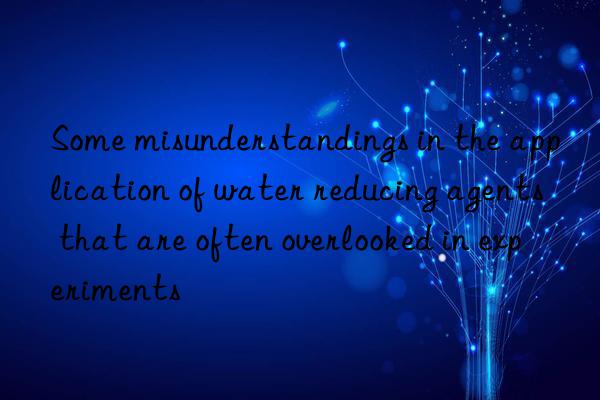
For many people who have been in the construction industry for a short period of time, water-reducing agents can reduce water, increase strength, improve fluidity, and save cement (cementing materials). Water-reducing agents are also required to solve the problem of fresh concrete not segregating and preventing segregation. A series of working properties such as non-bleeding and non-dispersion are required, and water-reducing agents are even required to solve the problem of slump loss. This is actually a misunderstanding of the performance of water-reducing agents. There are still many misunderstandings about the actual construction application of water-reducing agents, which affects the application effect of admixtures in commercial concrete construction.
(1) It is quite incorrect that high-concentration naphthalene water-reducing agents are better than low-concentration products. The difference between the two products is only the sodium sulfate content in the product. Generally, the sodium sulfate content of high-concentration products is 3% to 5%, while the sodium sulfate content of low-concentration products is 18% to 20%. On the surface, the high-concentration product, naphthalene sulfonate The effective content of acid-formaldehyde condensate is higher than that of low-concentration products.
However, since the adsorption capacity of C3A to water-reducing agent in cement is larger, the amount of C3A adsorbed by high-concentration products is also large, and the remaining part can be used to absorb water-reducing agents. C3S, which is a large mineral component in cement, plays a dispersing role. The sulfate in low-concentration products will be adsorbed preferentially by C3A in large quantities. The remaining active ingredients can still have a similar dispersion effect on other mineralized components in cement as high-concentration products.
(2) Some water-reducing agents have bleeding or color problems and are considered unsuitable for use in commercial concrete. This mainly refers to aliphatic water-reducing agents. Due to the high water-reducing rate of this product and the lack of water-retaining ingredients, it may affect the water retention of concrete and cause the concrete to bleed and segregate. Ingredients can be avoided.
Because this product is synthesized under alkaline conditions, the product mostly appears red or dark red. If it is added to concrete to produce bleeding, a layer of yellow liquid will appear on the surface of the concrete. This is not a problem. After watering and curing, there will be no yellow water seepage and it will not affect the appearance of the concrete.
(3) Water-reducing agent has a low water-reducing rate and is not suitable for use as a water-reducing agent in commercial concrete.
Water-reducing agent is a kind of water-reducing agent that is added before or during the mixing of concrete. , an admixture that can reduce or significantly reduce the water used in concrete mixing. Adding water-reducing agents to concrete can effectively improve the workability and fluidity of concrete, improve the structure of concrete, and increase strength. It can also save a lot of cement while maintaining the strength of concrete. Therefore, water-reducing admixture has also become an indispensable admixture for preparing commercial concrete.
Seeing that water-reducing agents can improve strength and save a lot of cement, construction workers mistakenly believe that when preparing commercial concrete using water-reducing agents, the higher the water-reducing rate, the better, even when preparing low-grade concrete. Concrete also requires a higher water reduction rate. Normally, as the water reduction rate increases, the strength of the concrete will become higher and higher. For concrete with a high water-cement ratio, reducing water consumption will also reduce the drying shrinkage of the concrete, which is of course very beneficial to improving the strength of the concrete and reducing shrinkage and cracking of the concrete. However, the current water-to-cement ratio in concrete construction is generally designed to be relatively low. Since self-shrinkage cannot be ignored, if water consumption is significantly reduced, the internal drying shrinkage of the concrete will increase, thus increasing the self-shrinkage of concrete. In addition, the preparation of commercial concrete is generally difficult. When retarders are added together, due to slower hydration, the concrete will not set for a longer period of time, resulting in serious water loss on the surface of the concrete, which increases the risk of shrinkage and cracking of the concrete. Of course, some people will say that we can prevent concrete from drying out and shrinking through watering and curing, but very low water glue is denser than concrete, and the watering rarely penetrates into the concrete, and it is difficult to replenish the water shortage. Purpose.
</p



 微信扫一扫打赏
微信扫一扫打赏
